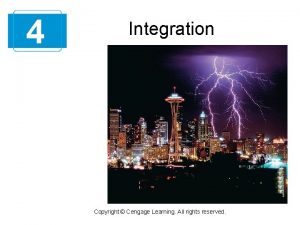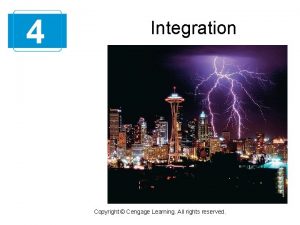4 Integration Copyright Cengage Learning All rights reserved


























- Slides: 26

4 Integration Copyright © Cengage Learning. All rights reserved.

4. 1 Antiderivatives and Indefinite Integration Copyright © Cengage Learning. All rights reserved.

Objectives n Write the general solution of a differential equation. n Use indefinite integral notation for antiderivatives. n Use basic integration rules to find antiderivatives. n Find a particular solution of a differential equation. 3

Antiderivatives 4

Antiderivatives Suppose you were asked to find a function F whose derivative is f(x) = 3 x 2. From your knowledge of derivatives, you would probably say that The function F is an antiderivative of f. 5

Antiderivatives 6

Antiderivatives You can represent the entire family of antiderivatives of a function by adding a constant to a known antiderivative. For example, knowing that Dx [x 2] = 2 x, you can represent the family of all antiderivatives of f(x) = 2 x by G(x) = x 2 + C Family of all antiderivatives of f(x) = 2 x where C is a constant. The constant C is called the constant of integration. 7

Antiderivatives The family of functions represented by G is the general antiderivative of f, and G(x) = x 2 + C is the general solution of the differential equation G'(x) = 2 x. Differential equation A differential equation in x and y is an equation that involves x, y, and derivatives of y. For instance, y' = 3 x and y' = x 2 + 1 are examples of differential equations. 8

Example 1 – Solving a Differential Equation Find the general solution of the differential equation y' = 2. Solution: To begin, you need to find a function whose derivative is 2. One such function is y = 2 x. 2 x is an antiderivative of 2. Now, you can use Theorem 4. 1 to conclude that the general solution of the differential equation is y = 2 x + C. General solution 9

Example 1 – Solution cont’d The graphs of several functions of the form y = 2 x + C are shown in Figure 4. 1 10

Notation for Antiderivatives 11

Notation for Antiderivatives When solving a differential equation of the form it is convenient to write it in the equivalent differential form The operation of finding all solutions of this equation is called antidifferentiation (or indefinite integration) and is denoted by an integral sign ∫. 12

Notation for Antiderivatives The general solution is denoted by The expression ∫f(x)dx is read as the antiderivative of f with respect to x. So, the differential dx serves to identify x as the variable of integration. The term indefinite integral is a synonym for antiderivative. 13

Basic Integration Rules 14

Basic Integration Rules The inverse nature of integration and differentiation can be verified by substituting F'(x) for f(x) in the indefinite integration definition to obtain Moreover, if ∫f(x)dx = F(x) + C, then 15

Basic Integration Rules These two equations allow you to obtain integration formulas directly from differentiation formulas, as shown in the following summary. 16

Basic Integration Rules cont’d 17

Example 2 – Applying the Basic Integration Rules Describe the antiderivatives of 3 x. Solution: So, the antiderivatives of 3 x are of the form C is any constant. where 18

Basic Integration Rules Note that the general pattern of integration is similar to that of differentiation. 19

Initial Conditions and Particular Solutions 20

Initial Conditions and Particular Solutions You have already seen that the equation y = ∫f(x)dx has many solutions (each differing from the others by a constant). This means that the graphs of any two antiderivatives of f are vertical translations of each other. 21

Initial Conditions and Particular Solutions For example, Figure 4. 2 shows the graphs of several antiderivatives of the form for various integer values of C. Each of these antiderivatives is a solution of the differential equation Figure 4. 2 22

Initial Conditions and Particular Solutions In many applications of integration, you are given enough information to determine a particular solution. To do this, you need only know the value of y = F(x) for one value of x. This information is called an initial condition. For example, in Figure 4. 2, only one curve passes through the point (2, 4). To find this curve, you can use the following information. F(x) = x 3 – x + C General solution F(2) = 4 Initial condition 23

Initial Conditions and Particular Solutions By using the initial condition in the general solution, you can determine that F(2) = 8 – 2 + C = 4, which implies that C = – 2. So, you obtain F(x) = x 3 – x – 2. Particular solution 24

Example 7 – Finding a Particular Solution Find the general solution of and find the particular solution that satisfies the initial condition F(1) = 0. Solution: To find the general solution, integrate to obtain 25

Example 7 – Solution cont’d Using the initial condition F(1) = 0, you can solve for C as follows. So, the particular solution, as shown in Figure 4. 3, is Figure 4. 3 26
 Copyright 2015 all rights reserved
Copyright 2015 all rights reserved Copyright 2015 all rights reserved
Copyright 2015 all rights reserved Dell all rights reserved copyright 2009
Dell all rights reserved copyright 2009 Copyright © 2018 all rights reserved
Copyright © 2018 all rights reserved Cengage chapter 7
Cengage chapter 7 All rights reserved example
All rights reserved example All rights reserved sentence
All rights reserved sentence Freesound content licence
Freesound content licence Confidential all rights reserved
Confidential all rights reserved All rights reserved example
All rights reserved example Pearson education inc all rights reserved
Pearson education inc all rights reserved Microsoft corporation. all rights reserved.
Microsoft corporation. all rights reserved. Microsoft corporation. all rights reserved.
Microsoft corporation. all rights reserved. Microsoft corporation. all rights reserved.
Microsoft corporation. all rights reserved. Pearson education inc. all rights reserved
Pearson education inc. all rights reserved Warning all rights reserved
Warning all rights reserved Siprop
Siprop All rights reserved formula
All rights reserved formula Warning all rights reserved
Warning all rights reserved Confidential all rights reserved
Confidential all rights reserved Microsoft corporation. all rights reserved
Microsoft corporation. all rights reserved 2010 pearson education inc
2010 pearson education inc Gssllc
Gssllc Copyright 2010 pearson education inc
Copyright 2010 pearson education inc Pearson education inc. all rights reserved
Pearson education inc. all rights reserved Confidential all rights reserved
Confidential all rights reserved Airbus deutschland gmbh
Airbus deutschland gmbh


















































